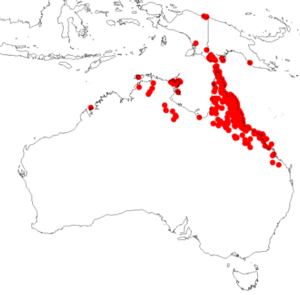Acacia simsii facts for kids
Quick facts for kids Acacia simsii |
|
|---|---|
| Scientific classification | |
| Genus: |
Acacia
|
| Species: |
simsii
|
 |
|
| Occurrence data from AVH | |
| SynonymsPWO/> | |
|
Racosperma simsii (A.Cunn. ex Benth.) Pedley |
|
Acacia simsii is a type of shrub often called heathlands wattle or Sims’ wattle. It belongs to the Acacia plant group, which is part of the Fabaceae family (also known as the pea or bean family).
This plant naturally grows in New Guinea and the northern parts of Australia. In Australia, you can find it in the Northern Territory and Queensland.
In the Territory, Acacia simsii grows in several natural areas called bioregions. These include Arnhem Coast, Cape York Peninsula, Einasleigh Uplands, Gulf Fall and Uplands, Gulf Plains, Northern Kimberley, Pine Creek, Tiwi Cobourg, and Wet Tropics.
You can see this wattle flowering in many months of the year, from January to November, except for March and August. It produces fruit almost all year round.
Contents
What Does Acacia Simsii Look Like?
Acacia simsii is a smooth shrub that usually grows to be about 1 to 4 meters (3 to 13 feet) tall.
Leaves and Flowers
Its leaves, called phyllodes, are long and narrow. They are usually straight and measure between 5 to 14 centimeters (2 to 5.5 inches) long and 2 to 7 millimeters (0.08 to 0.28 inches) wide. They have pointed tips and feel a bit leathery. Each phyllode has 3 or 4 main veins and a few smaller ones in between.
The plant's golden flowers grow in round clusters, about 3.5 to 4 millimeters (0.14 to 0.16 inches) across. Each cluster has 25 to 35 flowers. These flower clusters grow on short stems called peduncles, which are 5 to 12 millimeters long.
Pods and Seeds
After flowering, the plant produces flat, leathery pods. These pods can be up to 8 centimeters (3 inches) long and 4 to 7 millimeters (0.16 to 0.28 inches) wide. Inside the pods are dull brown-black seeds. The seeds are almost round or broadly oval, about 2.5 to 4 millimeters (0.1 to 0.16 inches) long. They have a small, club-shaped attachment called an aril.
Where It Grows Best
You can often find Acacia simsii growing in flat or gently rolling areas. It prefers sandy and gravelly soils. It commonly grows in open forests with Eucalyptus trees or in areas with thick, low-growing plants called heath. Sometimes, it can even form dense patches in disturbed areas.
This wattle is quite similar to another species, A. multisiliqua. However, A. multisiliqua generally has shorter leaves and different seeds.
How Was Acacia Simsii Named?
The first official description of Acacia simsii was made by a botanist named George Bentham in 1842. He wrote about it in a scientific paper called Notes on Mimoseae, with a synopsis of species.
Later, in 1987, another botanist named Leslie Pedley reclassified it. But in 2006, it was moved back into the Acacia group, where it remains today.
Is Acacia Simsii Protected?
Good news! In both the Northern Territory and Queensland, Acacia simsii is considered to be of Least Concern for conservation. This means it is not currently at risk of disappearing.

